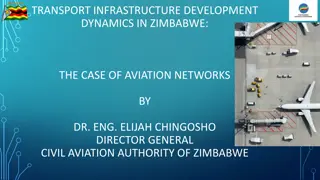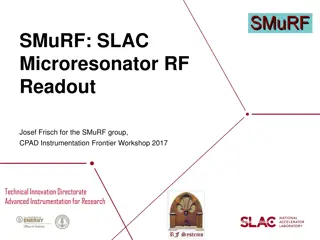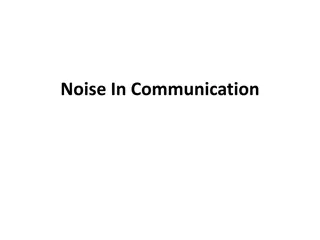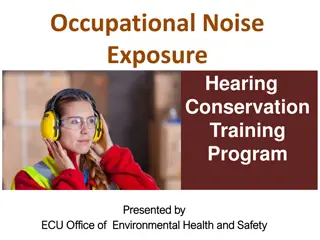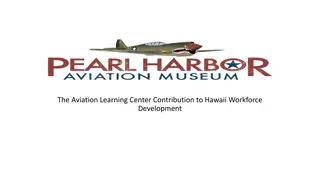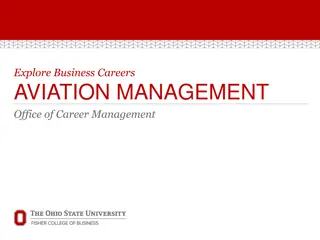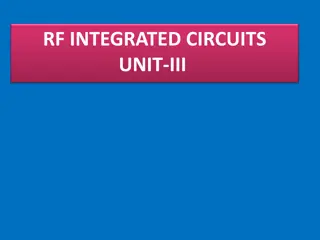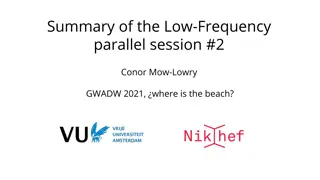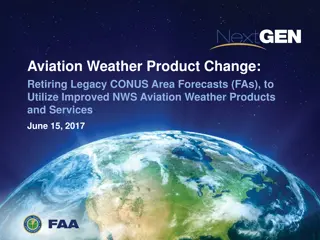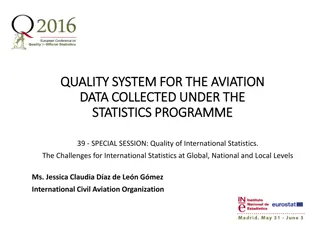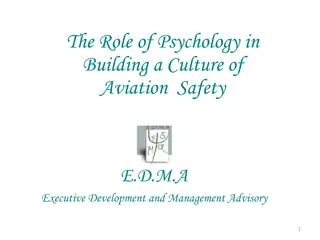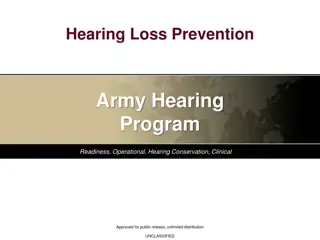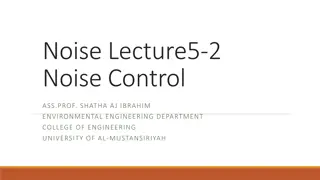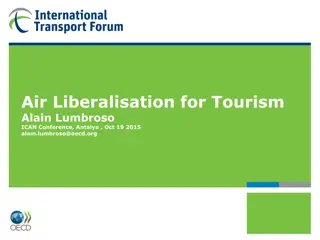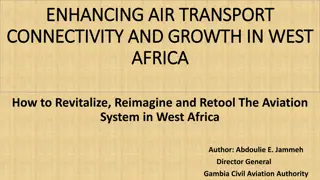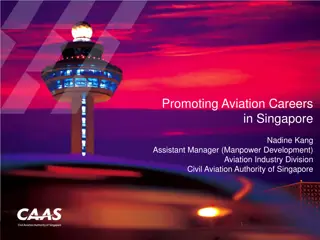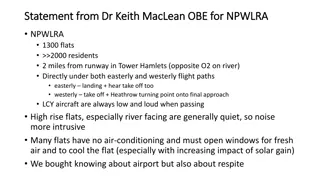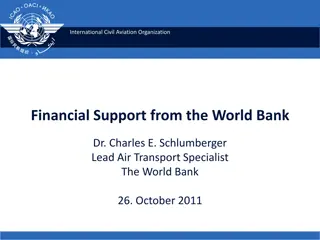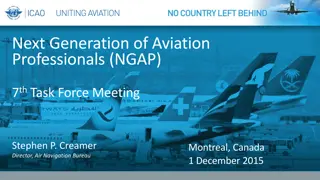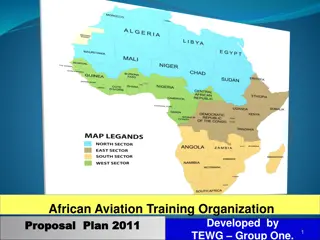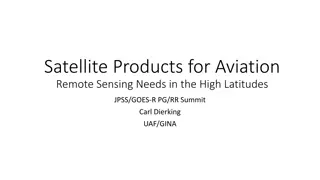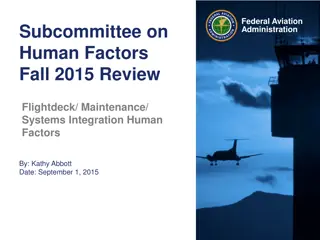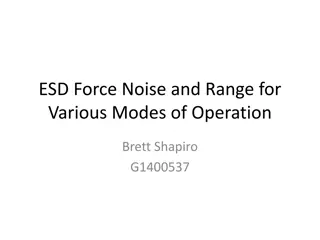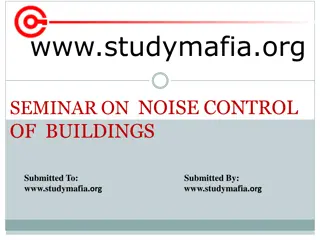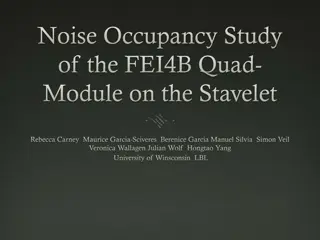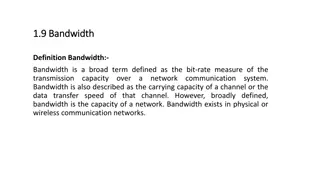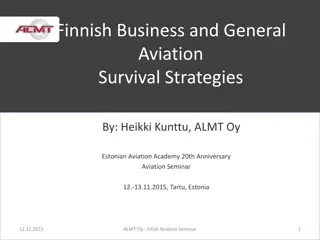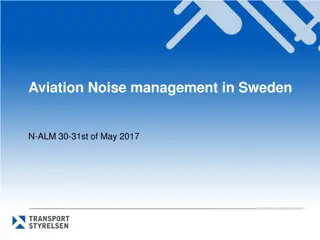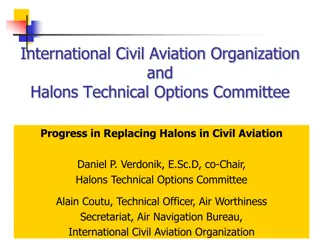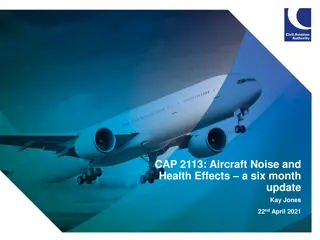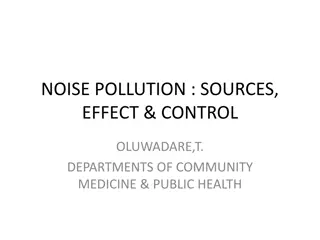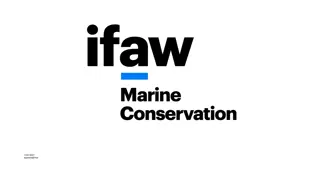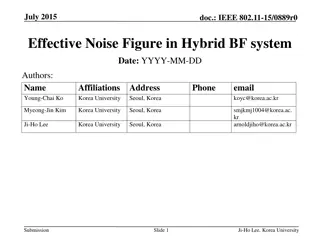South Sudan Civil Aviation Authority Overview
South Sudan Civil Aviation Authority (SSCAA) was established in 2012 to regulate the aviation industry in South Sudan. As a member of ICAO, SSCAA aims to provide efficient, safe, secure, reliable, and affordable aviation infrastructure and services. Challenges include financial autonomy and meeting
1 views • 10 slides
Development Dynamics of Aviation Networks in Zimbabwe
Aviation plays a crucial role in Zimbabwe's economic growth, with the government focusing on infrastructure development to position the country as a regional aviation hub by 2030. Initiatives include strengthening civil aviation systems, enhancing airport infrastructure, and prioritizing safety and
3 views • 15 slides
Understanding Frequency Weighting in Noise Pollution Measurement
Frequency weighting is essential in noise pollution measurement to reflect how the human ear perceives noise. The A, C, and Z weightings are commonly used to represent different frequency responses. A-weighting covers the audible frequencies where the human ear is most sensitive, while C-weighting i
2 views • 7 slides
SMuRF: SLAC Microresonator RF Readout
SMuRF group at SLAC developed a cutting-edge RF readout system for cryogenic micro-resonators used in research. The system features cold resonators tuned with TES current and a flux ramp to eliminate 1/f noise. Key technical challenges include noise, linearity, wide bandwidth, and computation power.
4 views • 16 slides
Understanding Noise in Communication Systems
Noise in communication refers to unwanted energy that interferes with signal reception and transmission. It can be categorized as external or internal noise, each with various subtypes like atmospheric noise and shot noise. Recognizing and managing different types of noise is essential for ensuring
1 views • 8 slides
Occupational Noise Exposure and Hearing Conservation Training Program
Learn about the Occupational Noise Exposure and Hearing Conservation Training Program presented by the Office of Environmental Health and Safety at ECU. This program aims to educate workers about the risks of noise-induced hearing loss, the importance of prevention, and the selection of appropriate
1 views • 20 slides
The Aviation Learning Center: Empowering Hawaii's Workforce
The Aviation Learning Center (ALC) at the Pearl Harbor Aviation Museum offers an immersive hands-on learning experience for students of various age groups, focusing on aviation concepts and practical applications. The program includes educational modules, flight simulators, and a curriculum aligned
0 views • 7 slides
Explore Careers in Aviation Management
Aviation management involves overseeing flight operations and preparing students for professional positions in the aviation industry. Success in this field requires adaptability, communication, critical thinking, problem-solving, teamwork, and the ability to work under pressure. Sample roles include
0 views • 8 slides
Understanding Noise in RF Integrated Circuits: Thermal and 1/f Noise
Noise, an unwanted input, limits a system's ability to process weak signals. Sources of noise include random noise in resistors and transistors, mixer noise, undesired cross-coupling noise, and power supply noise. Thermal noise, caused by thermal agitation of charge carriers, is also known as Johnso
1 views • 49 slides
Insights from ET-ISB Workshop on Low-Frequency Noise and GWADW 2021
The ET Instrument Science Board held a workshop focusing on addressing key challenges related to low-frequency noise in gravitational wave detectors. Experts discussed topics such as mirror temperature, dealing with low-frequency noise realities, and facility limits. The workshop highlighted the sig
0 views • 13 slides
Advanced Understanding of Low-Frequency Noise in Instrumentation
Understanding low-frequency noise in instrumentation has advanced significantly, emphasizing the need for an integrated approach to predict and mitigate such noise. Recent studies show that low-frequency noise in third-generation instruments is exceptionally better than in second-generation detector
0 views • 11 slides
Understanding Noise in Communication Systems
Noise in communication systems refers to unwanted signals that interfere with desired signals, originating from various sources such as interference from human-made sources and naturally occurring random noise. This noise can arise from factors like cross talk, power supplies, ignition systems, and
0 views • 19 slides
Understanding Receivers and Noise in Radio Astronomy
Discover the challenges faced in radio astronomy due to noise, with the signal often indistinguishable from background noise. Learn about receiver sensitivity issues, minimizing thermal noise, and mitigating atmospheric effects to improve observation quality. Explore the essential elements of telesc
0 views • 55 slides
Transition of Legacy CONUS Area Forecasts in Aviation Weather Modernization
On June 15, 2017, the National Weather Service announced a transition plan to retire legacy CONUS Area Forecasts (FAs) and adopt improved aviation weather products and services. The transition period will last three months, with full implementation expected by October 10, 2017. The goal is to enhanc
5 views • 9 slides
Quality System for the Aviation Data in ICAO
International Civil Aviation Organization (ICAO) is responsible for collecting, analyzing, and disseminating statistics related to civil aviation. The quality system for aviation data ensures relevance, accuracy, timeliness, accessibility, comparability, and coherence of the collected data. ICAO's s
0 views • 7 slides
The Role of Psychology in Aviation Safety Culture
Psychology plays a crucial role in building a culture of aviation safety by studying and preempting the psychological stressors faced by aviation staff. Aviation psychology focuses on human behaviors, cognitive functioning, and emotional processes in the complex aviation environment, with a history
0 views • 24 slides
Protect Your Hearing: Strategies for Prevention
Strategies for minimizing noise-related threats in operational environments are crucial to prevent permanent hearing loss. Understanding the risks of loud noise exposure, utilizing hearing protection, undergoing regular audiometric testing, and maintaining noise records are essential components of t
0 views • 22 slides
Understanding Noise Pollution: Sources, Terminology, and Measurement
Noise pollution is defined as undesirable sounds that disrupt human and animal life. This article explores the sources of noise pollution, terminology used in its measurement, and its impact on urban environments. Major sources include traffic noise, industrial machinery, and household activities. U
1 views • 26 slides
Understanding Noise Control Methods in Environmental Engineering
Explore the concepts of noise control in environmental engineering, focusing on mufflers, reactive mufflers, and noise control in the transmission path. Learn about absorptive and reactive mufflers, their principles, and applications. Discover how barriers and panels can effectively reduce noise tra
0 views • 9 slides
Role of Aviation in Tourism Liberalisation and Development
Explore the significance of aviation in tourism liberalisation through insights on the International Transport Forum, tourism impact on GDP, employment, and exports, tourists' preferences for freedom in air travel, and a comparison of aviation with other tourism services. The content delves into the
0 views • 12 slides
Enhancing Air Transport Connectivity and Growth in West Africa: Strategies for Revitalizing the Aviation System
Abdoulie E. Jammeh, Director General of Gambia Civil Aviation Authority, discusses the pre-COVID-19 achievements in the aviation sector in West Africa and the current/future challenges faced due to the pandemic. The article emphasizes on revitalizing, reimagining, and retooling the aviation system b
0 views • 6 slides
Enhancing Aviation Career Opportunities in Singapore
Promoting aviation careers in Singapore is a priority for the Civil Aviation Authority of Singapore (CAAS) under the SkillsFuture initiative. The Sectoral Manpower Plan aims to uplift the quality of manpower in the aviation industry by addressing challenges such as attracting local talent, providing
0 views • 21 slides
Concerns Regarding Airplane Noise Impact on Residents in Tower Hamlets
Dr. Keith MacLean OBE provides a statement on the impact of airplane noise on over 2000 residents living in 1300 flats within a 2-mile radius of a London airport in Tower Hamlets. The residents face challenges with noise disturbance from easterly and westerly flight paths, with proximity to both lan
0 views • 10 slides
World Bank Support for Pacific Aviation Development
The World Bank has been actively involved in providing financial support for aviation development projects, particularly in the Pacific region. Through initiatives like the Pacific Aviation Investment Program and support for the Pacific Aviation Safety Office, the World Bank aims to enhance infrastr
0 views • 16 slides
Next Generation of Aviation Professionals (NGAP) Task Force Meeting Overview
The Next Generation of Aviation Professionals (NGAP) Task Force meeting was held on December 1, 2015, in Montreal, Canada. The NGAP aims to develop strategies for attracting, training, and retaining aviation professionals to ensure a safe and sustainable global air transportation system. The Task Fo
0 views • 24 slides
Proposal for the Creation of African Aviation Training Organization (AATO)
The proposal outlines the development of AATO, a continental body aimed at standardizing and harmonizing aviation training in Africa. Four Regional Aviation Training Boards will collaborate with ICAO to enhance accreditation and training quality across the continent, addressing common challenges fac
1 views • 23 slides
Satellite Products for Aviation Remote Sensing Needs in High Latitudes
Addressing the specific needs of aviation remote sensing in high latitudes, this content explores the importance of satellite products, variations in equipment requirements, data expectations, and the significance of cloud products for aviation safety. Feedback from aircraft operators emphasizes the
0 views • 8 slides
Federal Aviation Administration Subcommittee on Human Factors Fall 2015 Review
This document discusses the review of flight deck and maintenance systems integration human factors by Kathy Abbott in September 2015. It outlines the purpose, benefits, and success factors of the BLI Portfolio Overview related to human factors in aviation operations. Furthermore, it presents core f
0 views • 10 slides
Understanding ESD Force, Noise, and Range in Various Modes
This content discusses ESD force, noise, and range in different modes of operation, presenting assumptions, possible operation modes, and details on maximum range mode and noise characteristics. It explores concepts like control voltage offset, force noise calculations, and practical applications fo
0 views • 9 slides
Noise Control Measures and Community Preferences at the Corn Exchange
Various images and references discuss the history of amplified music events at the Corn Exchange, noise complaints leading to control methods by the FTC, impacts on events and community preferences post-control, and survey findings on participant demographics, noise effects, and desired public event
0 views • 19 slides
Noise Control Strategies for Buildings: A Comprehensive Seminar Overview
Explore the impact of noise on health, methods to control noise in buildings, and various techniques including room acoustics, wall and floor construction, space planning, HVAC soundproofing, and more. Understand the importance of noise reduction for overall well-being and effective sound management
0 views • 20 slides
Noise Occupancy Study of FEI4B Quad Module: Troubleshooting and Solution
This study delves into the noise occupancy of the FE-I4B chips on the quad module mounted on the Stavelet, addressing unexpected noise increases, problem tracing, and cross-checking between USBpix and RCE. Early studies pinpoint temperature control and suspected unstable grounding. The comparison be
0 views • 21 slides
Understanding Bandwidth, Channel Capacity, and Noise in Communication Networks
Bandwidth is a crucial aspect of network capacity, describing the data transfer speed and carrying capacity of a channel. Channel capacity involves factors like data rate, bandwidth, noise, and error rate. Noise sources include thermal noise, impulse noise, and delay distortion, impacting signal qua
0 views • 5 slides
Challenges and Strategies in Finnish Aviation Industry
The Finnish aviation industry faces challenges in general and business aviation, with rising costs, older pilot demographics, and declining interest among the youth. ALMT Oy discusses survival strategies and adaptation measures at the Estonian Aviation Academy seminar.
0 views • 11 slides
Aviation Noise Management Strategies in Sweden
Aviation noise management in Sweden focuses on a balanced approach with four principal elements: noise reduction at the source, adherence to ICAO noise standards, differentiated landing fees, and operating restrictions. Competent authorities such as the Swedish Environmental Protection Agency and Sw
1 views • 4 slides
Progress in Replacing Halons in Civil Aviation: ICAO Initiatives
In the journey to replace halons in civil aviation, the International Civil Aviation Organization (ICAO) has made significant strides with the Halons Technical Options Committee. Starting from the engagement in 2003 to the establishment of mandates in 2010, various decisions and agreements have shap
0 views • 9 slides
Understanding the Impact of Aircraft Noise on Health - Recent Update
This report provides a six-month update on recent research findings regarding aircraft noise and its effects on health. Saucy et al. studied the association between aircraft noise exposure and cardiovascular mortality, particularly at night, with significant findings related to increased odds of nig
0 views • 20 slides
Understanding Noise Pollution: Sources, Effects, and Control
Noise pollution is a significant environmental issue resulting from unwanted sounds in various settings. This article delves into the properties of sound, measurement techniques, sources of noise, effects of noise exposure, and strategies for control and mitigation, shedding light on the impact of n
0 views • 16 slides
Addressing Underwater Noise Pollution in EU Waters: Urgent Action Needed
Whales, dolphins, and other marine life are severely impacted by underwater noise pollution caused primarily by shipping activities in EU waters. Urgent implementation of stricter regulations based on IMO guidelines is essential to reduce noise levels and protect marine ecosystems. Recommendations i
0 views • 4 slides
Noise Figure Analysis in Hybrid Beamforming Systems
This document discusses the theoretical study of noise figure (NF) and gain in hybrid beamforming systems, focusing on the impact of additional RF blocks, such as phase shifters and combiners, on noise figure calculations. It explains how the received signals from multiple antennas are phase-correct
0 views • 11 slides

